By going through these CBSE Online Education Class 12 Accountancy Notes Chapter 4 Reconstitution of Partnership Firm: Retirement/Death of a Partner, students can recall all the concepts quickly.
Online Education for Reconstitution of Partnership Firm: Retirement/Death of a Partner Notes Class 12 Accountancy Chapter 4
As we already knew that reconstitution of the partnership firm can also take place on the retirement of the partner or death of the partner. Here, the existing partnership deed comes to an end, and in its place, a new partnership deed comes into existence where remaining partners shall continue to do the business but on different terms and conditions. In both cases, i.e. on retirement or death of a partner, we are required to determine the sum due to the retiring partner or to the legal representatives of the deceased partner.
Retirement of a Partner:
A partner may retire from the partnership firm:
- with the consent of all other partners;
or - in case of retirement at will i.e. (partnership at will);
or - by giving notice in writing to all other partners by the retiring partner.
On retirement, the old partnership comes to an end arid a new one between the remaining partner1 comes into existence. However the partnership firm as such continues.
Amount due to Retiring Partner:
- Credit Balance of his Capital Account;
- Credit Balance of his Current Account (if any);
- His share of goodwill, accumulated profits, reserves etc.;
- His share in the profit on revaluation of assets and liabilities;
- His share of profit, interest on capital up to the date of retirement;
- Any salary/commission due to him.
The following deductions (if any) made from his share:
- Debit balance of the his-current account (if any);
- His share of Goodwill to be written off, accumulated losses;
- His share of loss on revaluation of assets and liabilities;
- His share of loss, drawing and interest on drawings up to the date of retirement.
The various accounting aspects involved in retirement or death are as follows:
- New profit sharing ratio
- Gaining ratio
- Goodwill Treatment
- Accumulated profit and losses -Distribution
- Profit and Loss till the date of retirement or death
- Adjustment of Capital
- Settlement of the amount due to retired /deceased partner.
New Profit Sharing Ratio:
The new profit sharing ratio is the ratio in which the remaining partners will share future profits after the retirement or death of any partners. In other words, the new profit sharing ratio of each remaining partner will be the sum total of his old share of profits in the firm and the portion of the retiring partner’s share of the profit acquired.
New Share of Partner = Old share + Acquired share from retiring/deceased partner.
(a) Nothing is mention about the new profit sharing ratio at the time of retirement:
If nothing is stated about the future ratio of the remaining partner, then their old ratio is considered as their new ratio. In other words, in the absence of any information regarding the profit-sharing ratio in which the remaining partner acquire the share of the retiring/deceased partner, then it is assumed that they will acquire it in the old profit sharing ratio and so the share the future profits in their old ratio.
For example, Kapil, Anu and Priti are partners in firm sharing profits and losses in the ratio 5: 3: 2. If Anu retires, then the new profit sharing ratio of Kapil and Priti will be 5: 2.
(b) Remaining partners acquire the share of retiring/deceased partner in the specified ratio:
If the remaining partners acquire the share of retiring/deceased partner in a specified ratio, other than their old ratio, then there is a need to compute a new profit sharing ratio among them. The new profit sharing ratio is equal to the sum total of their old ratio and the share acquired from the retiring/deceased partner.
For example, Kapil, Anu and Priti are partners in firm sharing profits and losses in the ratio 5: 3: 2. If Anu retires from the firm and her share was acquired by Kapil and Priti in the ratio 2: 1. In that case, the new share of profit will be calculated as follows:
New share of remaining partner = Old share + Acquired share from the outgoing partner.
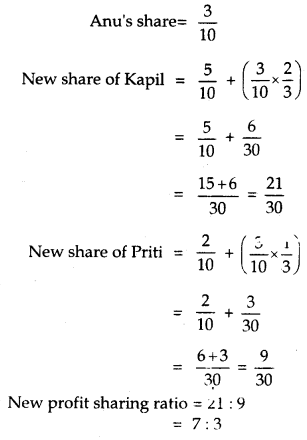
(c) Remaining partners may agree on a particular new profit sharing ratio:
If the remaining partners decide a particular profit sharing ratio to share the future profits of the firm, in such a case the ratio so specified will be the new profit sharing ratio.
Gaining Ratio:
The ratio in which the continuing partners acquire the share of the retiring /deceased partner is called the gaining ratio.
(a) If nothing is mention in agreement:
If nothing is mention in the agreement about the gaining ratio, then it is assumed that the remaining partners acquire the share of the retiring/deceased partner in their old profit sharing ratio. In that case, the gaining ratio of the remaining partners will be the same as their old profit sharing ratio and there is no need to compute the gaining ratio.
(b) If a new profit sharing ratio is given:
If the new profit sharing ratio is given of the remaining partners then we have to compute the gaining ratio. In this case, the gaining ratio is calculated by deducting the old ratio from the new ratio.
Gaining ratio = New ratio – Old ratio
For example X, Y and Z are partners in a firm, sharing profits and losses in ratio 5:3:2. Y retires from the firm and X and Z decide to share future profits and losses in the ratio 7: 3. The gaining ratio will be calculated as follows:
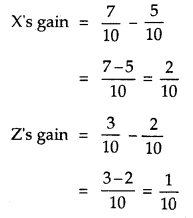
Treatment of Goodwill:
The outgoing partner is entitled to his share of goodwill at the time of retirement/death because the goodwill has been earned by the firm with the efforts of all the existing partners. Therefore, goodwill is valued as per the agreement, at the time of retirement/death.
Due to the retirement/death of any partner, the continuing partners make again because the future profit will be shared only between the continuing partners. Therefore, the continuing partners should compensate the retiring/deceased partner for his share of goodwill in the gaining ratio.
The accounting treatment for goodwill depends upon whether the goodwill already appears in the books of the firm or not.
When Goodwill does not Appear in the Books:
When Goodwill does not appear in the books of the firm, there are four following ways to compensate the retiring partner for his share of goodwill:
(a) Goodwill is raised at its full value and retained in the books:
Goodwill A/c Dr.
To All Partner’s Capital AJc’s
(including retiring/deceased partner)
(For the goodwill raised at its full value and credited to capital A/c’s of a ’1 partners in their old profit sharing ratio)
The full value of goodwill will appear in the new balance sheet.
(b) Goodwill is raised at its full value and written off immediately:
If it is decided that the goodwill will not appear in the balance sheet of the reconstituted firm, then the following journal entries are required:
1. Goodwill A/c Dr.
To All Partner’s Capital A/c’s (For raising of Goodwill and credited to all partners capital A/c’s in their old profit sharing ratio)
2. Continuing Partner’s Capital A/c’s Dr.
To Goodwill A/c
(For written off goodwill between continuing partners in their new profit sharing ratio)
(c) Goodwill is raised to the extent of retired/deceased partner’s share and written off immediately:
1. Goodwill A/c Dr.
To Retiring/Deceased Partner’s Capital A/c (For the goodwill raised by share of outgoing partner)
2. Continuing Partner’s Capital AJc’s Dr.
To Goodwill A/c
(For the goodwill written off between the continuing partners in their gaining ratio)
(d) No Goodwill account is raised at all in the firm’s books:
If the outgoing partner’s share of goodwill is adjusted in the capital accounts of the continuing partners without opening a goodwill account, the following entry will be required:
Continuing Partner’s Capital A/c’s Dr.
To Outgoing Partner’s Capital A/c (For the share of outgoing partner in the goodwill adjusted through capital accounts in the gaining ratio)
The following example clears the above accounting treatment of Goodwill at the time of retirement/death:
Ram, Shyam and Mohan are partners in firm sharing profits and losses in the ratio of 5: 3: 2. Shyam retires. The goodwill of the firm is valued at Rs. 1,40,000 and the remaining partner’s Ram and Mohan continue to share profits in the ratio of 5:2. The following journal entries passed under various alternatives shall be as follows:
If goodwill is raised at full value and retained in books:
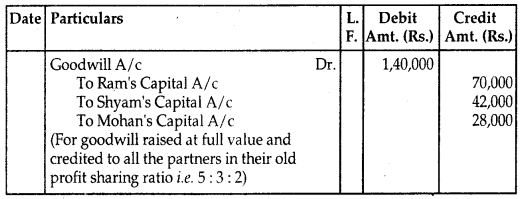
If goodwill is raised at full value and written off immediately:
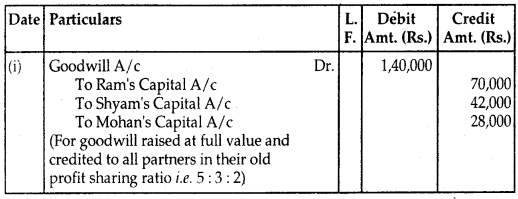

If goodwill is raised to the extent of retiring partner’s share and written off immediately:
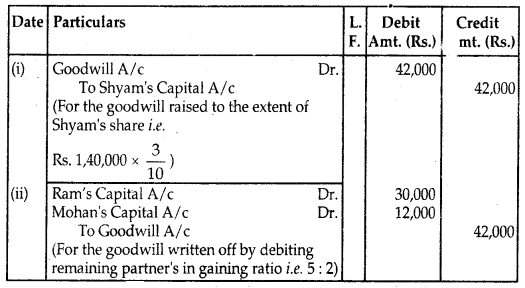
No goodwill account is raised at all in the firm’s books:
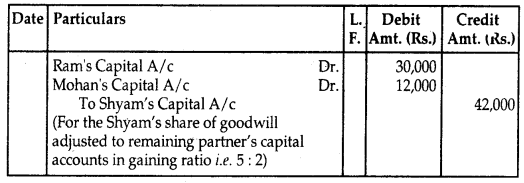
When Goodwill is already appearing in the books:
(a) If the value of goodwill appearing is equal to the current value of goodwill of the firm:
Normally, no adjustment is required if both the amounts are the same. Because goodwill stands credited in the accounts of all the partners including the retiring one.
(b) If the book value of goodwill is lower than its present value:
If the book value is less than the present value, the difference will be debited to the goodwill account and credited to the old partner’s capital accounts in their old profit sharing ratio.
Goodwill A/c Dr.
To All Partner’s Capital A/c’s (individually)
(For goodwill raised to its present value)
(c) If the book value of goodwill is more than the agreed or present value:
If the book value of goodwill is more than the present value, the difference will be debited to All partner’s capital accounts in their old profit sharing ratio and credited to the goodwill account.
All Partner’s Capital A/c’s (individually) Dr.
To Goodwill A/c
(For goodwill brought down to its present value)
Alternatively,
1. First, write off the existing goodwill that appears in the books:
All Partner’s Capital A/c’s (individually) Dr.
To Goodwill A/c
(For write off goodwill to all partners in old profit sharing ratio)
2. Adjust retiring partner’s share of goodwill through capital A/c’s
Remaining Partner’s Capital A/c’s Dr.
To Retiring/deceased Partner’s Capital A/c
(For goodwill share of retiring/deceased partner adjusted to remaining partner’s Capital A/c’s in their gaining ratio)
Hidden Goodwill:
If the firm has agreed to settle the retiring/deceased partner by paying him a lump sum, then the amount paid to him in excess of what is due to him based on the capital accounts balance after making all adjustments like accumulated profits and losses and revaluation profit or loss etc. shall be treated as his share of goodwill known as hidden goodwill.
Revaluation of Assets and Liabilities:
The retiring /deceased partner must be given a share of all profits that have arisen till his retirement/death and is made to bear his share of losses that have occurred till that period. This necessitates the revaluation of assets and liabilities. At the time of retirement/death of a partner, there may be some assets and liabilities which may not have been shown at their present values.
Not only that, there may be some unrecorded assets and liabilities which need to be brought into books. For this purpose, a revaluation account is opened, for the revaluation of assets and liabilities on the date of retirement/death of the partner. The journal entries to be passed for this purpose are as follows:
1. For increase in the value of assets:
Asset(s) AIc (individually) Dr.
To Revaluation A/c (For increase in the value of assets)
2. For decrease in the value of assets:
Revaluation A/c Dr.
To Assets A/c’s (individually)
(For decrease in the value of assets)
3. For increase in the number of liabilities:
Revaluation A/c Dr.
To Liabilities A/c’s (individually)
(for an increase in liabilities)
4. For decrease in the number of liabilities:
Liabilities A/c’s (individually) Dr.
To Revaluation A/c (For decrease in the liabilities)
5. For an unrecorded asset:
Assets A/c Dr.
To Revaluation A/c
(For unrecorded assets brought into books)
6. For an unrecorded liability:
Revaluation A/c Dr.
To Liability A/c
(For an unrecorded liability brought into books)
7. For the sale of an unrecorded asset:
Cash A/c Dr.
To Revaluation A/c (For the sale of unrecorded assets)
8. For payment of an unrecorded liability:
Revaluation A/c Dr.
To Cash A/c
(For the payment of an unrecorded*liability)
9. For-profit on revaluation:
Revaluation A/c Dr.
To All Partner’s Capital A/c’s (individually)
(For the distribution of profit on revaluation to all partners in their old profit sharing ratio)
Or
10. For Loss on revaluation:
All Partner’s Capital A/c’s (individually) Dr.
To Revaluation A/c
(For the distribution of losses on revaluation to all partners in their old profit sharing ratio)
Reserves and Accumulated Profits and Losses:
The retiring/deceased partner is also entitled to his/her share in the accumulated profits, general reserve, workmen compensation fund 1 etc. and is also liable to share the accumulated losses.
For this purpose the following journal entries are required:
1. For Transferring accumulated profits, General Reserves etc.
To All Partner’s Capital A/c’s (individually)
(For accumulated profits are transferred to all partner’s Capital A/c’s in their old profit sharing ratio)
2. For transfer of accumulated losses:
All Partner’s Capital A/c’s (individually) Dr.
To Profit and Loss A/c To Any Accumulated Loss A/c (For accumulated losses transferred to all partner’s Capital A/c’s in their old profit sharing ratio)
Settlement of Amount Due to Retiring Partner:
The retiring partner is entitled to the amount due to him. It is settled as per the terms of the partnership deed i.e. in lump sum immediately or in various instalments with or without interest as agreed or partly in cash immediately and partly in instalments.
In absence of any agreement, Section 37 of the Indian Partnership Act, 1932 is applicable, according to this, the retiring partner has an option to receive either interest 6% p.a. till the payment of his/her amount due or such share of profits which has been earned with his/her money i.e. based on the capital ratio. The necessary journal entries are as follows:
1. If payment (full) is made in cash:
Retiring Partner’s Capital A/c Dr.
To Cash/Bank A/c
(For the amount paid to retire partner)
2. If the amount due to retiring partner’s treated as loan:
Retiring Partner’s Capital A/c Dr.
To Retiring Partner’s Loan A/c (For the amount due to retiring partner transferred to his loan account)
3. When the amount due to retiring partner is partly paid in cash and the remaining amount treated as loan:
Retiring Partner’s Capital A/c Dr. (Total Amount Due)
To Cash/Bank A/c. (Amount paid)
To Retiring Partner’s Loaij A/c (Amount of loan) (For the amount due to retiring, partner; partly paid in cash and remaining transferred to his loan account)
4. When loan account is settled by paying in instalment includes principal and interest:
(a) For interest due on loan:
Interest on Loan A/c Dr.
To Retiring Partner’s Loan A/c
(For the interest due on the loan of retiring partner)
(b) For payment of instalment of the loan with interest:
Retiring Partner’s Loan A/c Dr.
To Cash/Bank A/c
(For the amount paid (Instalment + Interest) to retiring
partner)
These entries i.e. (a) and (b) repeated till the loan is paid off.
Adjustment of Partner’s Capital:
At the time of retirement or death of a partner, the remaining partners may decide to adjust their capital contribution in their new profit sharing ratio. The adjustment of the remaining partner’s capitals may involve any one of the following cases:
1. When the total capital of a new firm is specified.
Steps:
(a) Compute the new capitals of the remaining partners by dividing total capital in their new profit sharing ratio.
(b) Calculate the amount of adjusted old capital of the remaining partners after all adjustments regarding goodwill, accumulated profit and losses, profit or loss on revaluation etc.
(c) Find out the surplus or deficiency, as the case may be, in each
of the remaining partner’s capital account by comparing the new capital and the adjusted capital. ‘
(d) Adjust the surplus by paying cash to the concerned partner or by crediting his Current Account as agreed. Adjust the deficiency by asking the concerned partner to pay cash or by debiting his current account.
Journal Entries:
For excess capital withdrawn by the remaining partners:
Partner’s Capital A/c’s (individually) Dr.
To Cash/Bank A/c.
For the amount of capital to be brought in by the partners:
Cash/Bank A/c Dr.
To Partner’s Capital AJc’s (individually)
If the adjustment is made through the current account:
For excess capital:
Partner’s Capital A/c’s (individually) Dr.
To Partner’s Current A/c’s (individually)
For short capital:
Partner’s Current A/c’s /individually) Dr.
To Partner’s Capital A/c’s (individually)
2. When the total capital of the new firm is not specified:
Calculate the total capital of the new firm which will be equal to the aggregate of the adjusted old capitals of the continuing partners after all adjustments like goodwill, accumulated profits and losses, profit and losses on revaluation etc.
After calculating the total capital of the new firm, follow the same steps as discussed in case 1.
3. When the amount payable to retiring partner will be contributed by continuing partners in such a way that their capitals are adjusted proportionately to their new profit sharing ratio:
Calculate the total capital of the reconstituted firm by adding the adjusted old capitals of remaining partners and the cash to be brought in by continuing partners in order to make payment to the retiring/ deceased partner.
Then follow the same step we discussed in case 1.
Death of a Partner:
The accounting treatment in the event of the death of a partner is the same as that in the case of the retirement of a partner. Here, his claim is transferred to his executor’s account and settled in the same manner as that of the retired partner.
The only major difference between the retirement and death of a partner is that retirement normally takes place at the end of the accounting period whereas death may occur on any day. Therefore, in case of death, his claim shall also include his share of profit or loss, interest on capital, interest on drawings (if any), from the beginning of the year to the date of death.
Calculation of profit for the intervening period:
Share of profit of a deceased partner
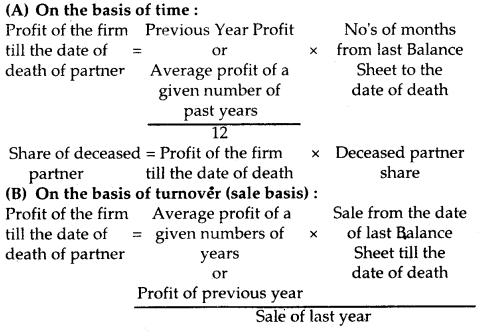
Share of deceased partner = Profit of the firm till the date of death × Deceased partner share
Accounting Treatment of Outgoing Partner’s Share in Profit:
1. Through Profit and Loss Suspense Account
In case of Profit:
Profit and Loss Suspense A/c Dr.
To Deceased Partner’s Capital A/c (Share of profit for the intervening period)
In case of Loss:
Deceased Partner’s Capital A/c Dr.
To Profit and Loss Suspense A/c (Share of loss for the intervening period)
2. Through Capital Transfer In case of Profit:
Remaining Partner’s Capital A/c’s Dr.
To Deceased Partner’s Capital A/c In case of Loss:
Deceased Partner’s Capital A/c Dr.
To Remaining Partner’s Capital A/c’s The executors of deceased partner are entitled to the following:
- The credit balance of deceased partner’s capital account;
- His share of goodwill;
- His share of profit till the date of death;
- His share of profit on revaluation of assets and liabilities;
- His share of accumulated profits and reserves;
- His interest on capital if partnership deed provides till the date of death;
- His share of Joint Life Policy (if any);
- His salary and commission due (if any);
The following deduction has to made from above.
- His drawings, interest in drawings till the date of death;
- His share of loss till the date of death;
- His share of loss on revaluation of assets and liabilities. ,
- His share of the reduction in the value of goodwill (if any).
Payment to the executors:
1. When payment is made in full Executor’s A/c Dr.
To Bank A/c.
2. When payment is made in instalment The executor’s are entitled to interest when the payment is made in instalment. If the deed is silent about this, then 6% p.a. should be given as per Section 37 of the Indian Partnership Act, 1932.
When interest is due
Interest A/c Dr.
To Executor’s A/c
When instalment paid along with interest
Executor’s A/c Dr.
To Cash/Bank A/c